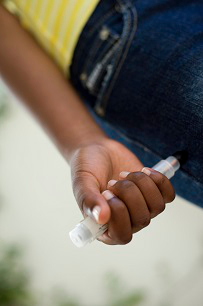Patient discussions
Advise the patient (or their parent and/or carer) after a first anaphylactic presentation about how to avoid the suspected trigger, recognise an anaphylactic reaction, and use an adrenaline (epinephrine) auto-injector.[52][Figure caption and citation for the preceding image starts]: Patient self-administering adrenaline autoinjectorIan Hooten/Science Photo Library [Citation ends]. Emphasise to the patient the importance of carrying both their adrenaline auto-injectors at all times, and that they should use one and call emergency services immediately if they suffer symptoms of anaphylaxis. You should also let people know about the possibility of biphasic reactions and to return to hospital should symptoms recur.[52]
Emphasise to the patient the importance of carrying both their adrenaline auto-injectors at all times, and that they should use one and call emergency services immediately if they suffer symptoms of anaphylaxis. You should also let people know about the possibility of biphasic reactions and to return to hospital should symptoms recur.[52]
In subsequent presentations check that the patient understands the points above. Written information leaflets can be helpful.[52]
Explain to the patient why a referral to an allergy/immunology specialist/clinic is important. The clinic can confirm the trigger of an anaphylactic episode, provide more information regarding allergen avoidance, and discuss immune therapy to prevent future episodes.[51]
Further information for patients and carers is available from the UK Anaphylaxis Campaign. Anaphylaxis Campaign Opens in new window
Use of this content is subject to our disclaimer